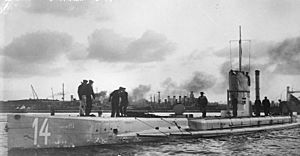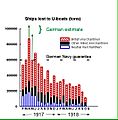First Battle of the Atlantic facts for kids
Quick facts for kids Battle of the Atlantic |
|||||||
|---|---|---|---|---|---|---|---|
| Part of World War I | |||||||
|
|||||||
| Belligerents | |||||||
Royal Canadian Navy, United States Navy Navy of France |
Navy of the German Empire |
||||||
| Commanders and leaders | |||||||
| Reinhard Scheer | |||||||
The First Battle of the Atlantic (1914–1918) was a naval campaign of World War I, largely fought in the seas around the British Isles and in the Atlantic Ocean. Both the German Empire and United Kingdom relied heavily on imports to feed their population and supply their war industry; thus both aimed to blockade each other. The British had the Royal Navy which was superior in numbers and could operate within the British Empire. The German Navy could not destroy the British Navy, as seen at the Battle of Jutland.
The German fleet mainly used unrestricted submarine warfare. Neutral countries disliked the blockades and the sinking of RMS Lusitania especially angered the United States. The successful blockade of Germany contributed to its military defeat in 1918, and still in effect, enforced also the signing of the Treaty of Versailles in mid-1919.
Contents
The Battle in Numbers
Allied and Neutral Tonnage sunk by submarines in World War I
| Month | 1914 | 1915 | 1916 | 1917 | 1918 |
|---|---|---|---|---|---|
| January | 47,981 | 81,259 | 368,521 | 306,658 | |
| February | 59,921 | 117,547 | 540,006 | 318,957 | |
| March | 80,775 | 167,097 | 593,841 | 342,597 | |
| April | 55,725 | 191,667 | 881,027 | 278,719 | |
| May | 120,058 | 129,175 | 596,629 | 295,520 | |
| June | 131,428 | 108,855 | 687,507 | 255,587 | |
| July | 109,640 | 118,215 | 557,988 | 260,967 | |
| August | 62,767 | 185,866 | 162,744 | 511,730 | 283,815 |
| September | 98,378 | 151,884 | 230,460 | 351,748 | 187,881 |
| October | 87,917 | 88,534 | 353,660 | 458,558 | 118,559 |
| November | 19,413 | 153,043 | 311,508 | 289,212 | 17,682 |
| December | 44,197 | 123,141 | 355,139 | 399,212 | |
| Total | 312,672 | 1,307,996 | 2,327,326 | 6,235,878 | 2,666,942 |
Grand Total 12,850,814 gross tons
Note that unrestricted submarine warfare was resumed in February 1917 and the British began full-scale convoying in September 1917. The heaviest losses were suffered in April 1917 when a record 881,027 tons were sunk by the U-boats.
Source: Fayle, C. Ernest, Seaborn Trade, Vol. 3, p. 465, Table I[a]; London: John Murray, 1924.
German Submarine Force 1914-1918
| 1914 | 1915 | 1916 | 1917 | 1918 | |
|---|---|---|---|---|---|
| On hand | 24 | 29 | 54 | 133 | 142 |
| Gains | 10 | 52 | 108 | 87 | 70 |
| Battle losses | 5 | 19 | 22 | 63 | 69 |
| Other losses | 8 | 7 | 15 | 9 | |
| Years end | 29 | 54 | 133 | 142 | 134 |
- Total operational boats: 351
- Total sunk in combat (50%): 178
- Other losses (11%): 39
- Completed after Armistice: 45
- Surrendered to Allied: 179
Images for kids
-
German U-boats at Kiel, February 1914
-
German depiction of the sinking of HMS Formidable by SM U-24
-
Diagram of the North Sea Mine Barrage, a large mine field to inhibit U-boat access to the Atlantic Ocean from the approaches between Orkney Islands to Norway











